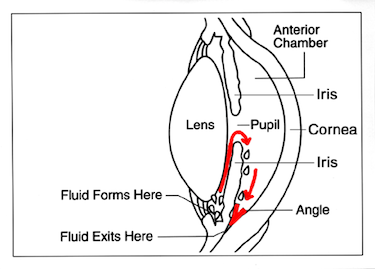“I can’t really do everything that my friends can,” my sister Diana tells SciJourner. Diana states that the font in her school’s textbooks is different from her classmates. When she reads, she must have the reading material not even a nose length away. Diana is only 9 years old and the doctors of Children’s Hospital in St. Louis have given her approximately 5–7 years to have sight.

Congenital glaucoma is condition that affects my little sister’s eyes. Not only is my little sister struggling with this condition, but my grandfather had this condition too. This disease caused him to become blind at the young age of 27.
The Glaucoma Foundation says that 4 million Americans have this condition, but only half know they have it. The National Eye Institute says that glaucoma is the second most common cause of blindness.
Glaucoma occurs most often in adults over the age of 40. It tends to run in families and families of African descent are at a particularly high risk for this condition. For African-Americans, glaucoma occurs at a younger age and with a greater loss in vision Glaucoma is 6- to 8-times more common in African-Americans than Caucasians. African-Americans are more likely to have diabetes that why they tend to have this condition, says the Foundation.
PubMed Health says glaucoma is a group of eye conditions that leads to damage to the optic nerve, which is the nerve that carries visual information from the eye to the brain. The Glaucoma Research Foundation states that congenital glaucoma is a result of the improper development of the eye canal. The damaged canal causes the eye not to be able relieve the pressure cause by the failure to drain the internal fluid. The pressure continues to build and press against the optic nerve until it’s permanently damaged or vision is lost. The consequences may be complete loss of vision.
The National Eye Institute says there are four major types of this condition: chronic, acute, congenital and secondary glaucoma. Chronic glaucoma, open angle, occurs when the fluid in the eye builds up and leaves the eye too slowly, increasing pressure to a level that damages the optic nerve. Acute glaucoma, or angle-closure, occurs when the exit of the aqueous humor fluid is suddenly blocked, which causes a sudden increase in pressure. This causes a quick, severe, and painful rise in the pressure on the optic nerve. Secondary results from eye injuries, such as eye surgery or eye inflammation.
Congenital glaucoma is said to be hereditary, but this is not proven. The symptoms of congenital glaucoma include red eye, tearing and enlargement of one or both eyes, which doctors can evaluate at birth.
Doctors can also run tests. The pressure in the eye is measured by firmness or tone (thickness) of its surface. When the eye is firm there isn’t really any pressure; the eye is normal. Then they test the thickness of the cornea. If it’s thick, then the pressure is building. Lastly, a type of eye exam called a visual field test occurs; it helps detect any signs of damage to the optic nerve, says PubMed Health.
Diana’s early treatments are extremely important, say her doctors. The treatment that Diana undergoes is laser surgery, which eliminates the fluid blockage. Eye drops also aid by reducing the formation of fluid in the front of the eyes. Every day Diana cries and rubs her eyes when her mother applies the drops.
Microsurgery is one of the most dangerous surgery options that she has had. This operation is called a trabeculectomy—a new channel is created to drain the fluid, reducing the pressure that causes glaucoma. Doctors go behind the eye and place and an actual tube to revive pressure. WebMD says that many patients that have had this surgery have permanent loss of vision, as well as bleeding or infection. But if these surgeries are done correctly most patients won’t have any more problems.
However, according to Children’s Hospital doctors, Diana will continue to have teary eyes, cloudiness of the eyes, and loss of vision. “I hate being treated special…I just want to be like my friends,” Diana confessed to SciJourner.

This work is licensed under a Creative Commons Attribution-NonCommercial-NoDerivs 3.0 Unported License














good story, but grammar is a bit below par. perhaps reedit before submitting a new article….
This was a good article for me to read because my grandmother, my aunt t, and my first cousin has glaucoma. I found it interesting how young someone can go blind. You do need to work on your grammar but good job as a overall article.
This article helped me because I didn’t know glaucoma could effect a person that bad.